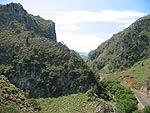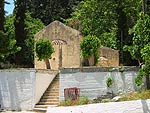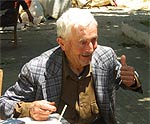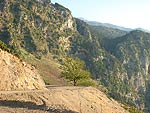| The historic village of Theriso,
15 km south of Chania, is a popular destination for excursions. The
village is situated at a height of 500 m, encircled by rounded mountains
at the foot of Lefka Ori whose naked tops contrast sharply with the dense
vegetation of the place.
|

|
The name (originally Therisos)
is of pre-Greek origin which testifies to the age of the village, but in
historical times, the village was mentioned for the first time in "Descrittione
dell' isola di Creta" (1577) by Francesco Barozzi.
|
|
|
|
|
|

|
The road from Chania winds
through the 6 km long and impressive Therisiano gorge, and in several
places you drive between vertical cliffs which at times actually project
over the road.
|
| The gorge is partially formed
by the river Kladissos which especially in spring when the snow melts,
changes into a torrent stream. |

|
|
|
|
|
 |
Two kilometres before Theriso,
a flight of steps to the right of the road leads up to the 20 m deep
Sarakina cave, where the archaeologist Paul Faure in the 1950'ies found
potsherds from Neolithic, late Minoan and pre-Geometric time. |
View from
the
Sarakina cave
|
|
|
|
| The strategic location of the
village has often given it a place in history. During
the great rebellion in 1821, the inhabitants and the partisans, under the
leadership of
Vasilis Chalis and Andreas
Fasoulis,
managed to put to flight 5.000 Turks at Kambia, at the entrance of the
gorge. The women of the village helped to bring water and ammunition.
According to tradition, a girl by the name of Andiánira from Theriso, was
shot at, while she was carrying water for the rebels in a bucket on her
head. The bucket was broken and she was slightly wounded, but her only
worry was the lost water.
|
| When pasha Mustafa Naili (Giritlis)
in 1886 burnt down the village, many of the inhabitants fled to
Kythira and Peloponnese, among them Styliani Ploumidaki and her only two-year-old son who was later to be one of
Greece's greatest politicians (Eleftherios Venizelos).
|
| The following year, the Cretan
rebels managed to isolate and wipe out two companies of Turkish soldiers
near Theriso. In revenge, Mustafa Naili killed the young girl Chrysi
Tsepeti by rolling a mill wheel over her. The wheel is now set up in the
middle of the village in front of a collection of war materials from World
War II. |

|
But Theriso became best known
in 1905 when Eleftherios Venizelos had his base there during the rebellion
against high commissioner Prince George.
|
| The high commissioner and
Venizelos were in total disagreement - to say the least of it - about how
Crete was going to achieve unification with Greece, which resulted in the
high commissioner's removal of Venizelos as minister of justice. In 1905,
after some years of controversies, Venizelos assembled revolutionaries
from the whole of Crete in Theriso where they proclaimed unification with
Greece and became the direct cause for George's resignation as high
commissioner. In the middle of the village is now established a
Venizelos-museum with photographs, documents and other evidence of the
Theriso rebellion. |

|
|
|
 |
Opposite the old Agios Giorgios
and Charalambos church from 1555 is the oldest café of the village, still
attended to by the old couple Maria and Artemis Papadakis. |
| During one of my visits, the
92-year-old Artemis told me about life in the old days and during the
Theriso rebellion. Click on the photo to the right to read his story. |

|
 |
The road continues from Theriso
over the mountains to the villages of Zourva and Meskla. During the drive,
there is a formidable view over the valley down towards the north coast
and Chania, while a vertical rock wall towers proudly to the left of the
road. |
|
|
|
|
|
|
|
|



